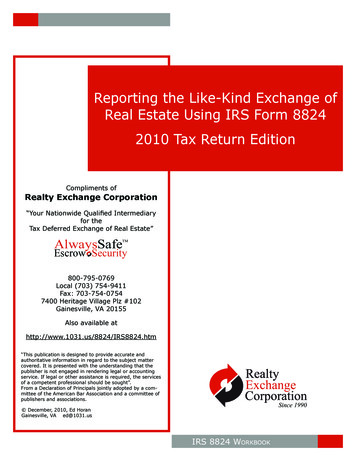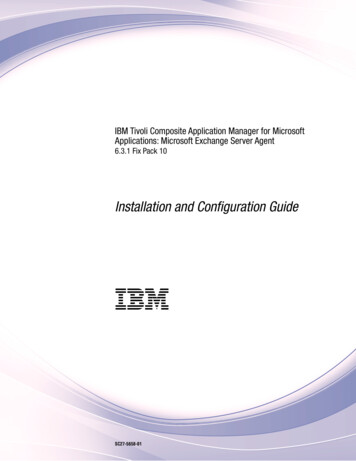
Transcription
Reporting the Like-Kind Exchange ofReal Estate Using IRS Form 88242010 Tax Return EditionCompliments ofRealty Exchange Corporation“Your Nationwide Qualified Intermediaryfor theTax Deferred Exchange of Real Estate”AlwaysSafeTMEscrow Security800-795-0769Local (703) 754-9411Fax: 703-754-07547400 Heritage Village Plz #102Gainesville, VA 20155Also available athttp://www.1031.us/8824/IRS8824.htm“This publication is designed to provide accurate andauthoritative information in regard to the subject mattercovered. It is presented with the understanding that thepublisher is not engaged in rendering legal or accountingservice. If legal or other assistance is required, the servicesof a competent professional should be sought”.From a Declaration of Principals jointly adopted by a committee of the American Bar Association and a committee ofpublishers and associations.Since 1990 December, 2010, Ed HoranGainesville, VA ed@1031.us10.5pt times roman italicIRS 8824 Workbook
2010 Tax Return EditionREPORTING THE EXCHANGEThis workbook was originally developed in the early 1990s when the IRS Form 8824was first created. The IRS Form 8824 is very complicated and uses terms of whichmost exchangers are not familiar. As exchangers had many questions, this Workbookwas published to be of assistance to them to properly report an exchange. While itspublisher is not engaged in rendering legal or accounting service every effort has beenmade to insure the guidance is in agreement with the IRS Form 8824 instructions.1. WHEN DO WE REPORT THE EXCHANGE TO THE IRS? The exchange is reported to theIRS for the tax year in which the first relinquished property is transferred, even if thereplacement property(ies) was transferred in the following tax year.Example: Exchanger settles on relinquished property on Dec. 15, 2010 and then settles on replacement property May 1, 2011. Exchanger would fileIRS Form 8824 with 2010 return, after filing an on-time request for anextension.2. HOW DO WE REPORT THE EXCHANGE? The Exchange is reported on IRS Form 8824,Like-Kind Exchanges. The IRS Form 8824 is divided into four parts:Part I.Part II.Part III.Part IV.Information on the Like-Kind ExchangeRelated Party Exchange InformationRealized Gain or (Loss), Recognized Gain, and Basis of Like-KindProperty ReceivedNot used for 1031 Exchange – Used only for Section 1043 Conflict ofInterest Sales.If the exchanger has recognized gain, in addition to IRS Form 8824, the exchanger mayneed to report the gain on IRS Form 4797, Sales of Business Property, Schedule D (IRSForm 1040), Capital Gains and Losses, and/or IRS Form 6252, Installment Sale Income.See paragraph 6 below.If you made more than one like-kind exchange in the same year, (a) you may reporteach exchange on a separate IRS Form 8824, or (b) you can file only one summary IRSForm 8824 and attach your own statement showing all the information requested onIRS Form 8824 for each exchange. Include your name and tax ID number at the top ofeach page of the statement. On the summary IRS Form 8824, enter only your nameand tax ID number, the word “Summary” on Line 1, the total recognized gain from allexchanges on Line 23, and the total basis of all like-kind property received on Line 25.3. COMPLETING PART I – INFORMATION ON THE LIKE-KIND EXCHANGE. For Lines 1and 2 in Part I, the exchanger should show for real property the address, and type ofproperty. For personal property a short description of the property should be entered. Allproperty involved in each exchange is included on the single IRS Form 8824. Include anattachment if additional space is required.Line 5 is normally the date the qualified intermediary was provided the identificationof the replacement property. In the event the replacement property settled prior tothe 45th day, then separate identification is not required, and the transfer date for thereplacement property is shown on Line 5. The date must be no later than 45 days afterthe date you transferred the relinquished property.4. COMPLETING PART II – RELATED PARTY EXCHANGE INFORMATION. Part II isonly completed when the replacement property was purchased/acquired from arelated party, directly or indirectly. A related party includes the exchanger’s spouse,child, grandchild, parent, grandparent, brother or sister, or a related corporation, Scorporation, partnership, or trust in which the exchanger has over a 50% interest. SeeIRC Section 1031(f). If the exchange is made with a related party and an exception doesIRS 8824 Workbook1
2010 Tax Return Editionnot apply, then you must also file IRS Form 8824 for the two years following the yearof the exchange. See specific IRS Form 8824 Instructions for Line 7. There have beena number of exceptions and clarifications on related party exchanges. If in doubt a taxadvisor shoud be consulted before claiming the exchage involved a related party.5. COMPLETING PART III – REALIZED GAIN OR (LOSS), RECOGNIZED GAIN, AND BASISOF LIKE-KIND PROPERTY RECEIVED. Part III is the most important and most difficultpart of the form to complete.Part III provides for the reporting of:a. Ordinary gain (or loss) on ‘other property’ (i.e. non-like property) given up(see Lines 12, 13, and 14)b. Ordinary income under the recapture rules (see Lines 21 and 22, andInstructions). Do not confuse with recapture of Section 1250 depreciation. Thereis no recapture if depreciable real property is exchanged for other depreciable realproperty. If depreciable real property is exchanged for non-depreciable real property(ex: rental house for land) then the total depreciation taken in excess of straight linecould be recaptured. If the value of depreciable property received in the exchange (ex:improvements to the land) exceeds the amount of additional or excess depreciation,then no depreciation will be recaptured. Few properties exist today that have excessdepreciation.c. Multi-Asset Exchanges. Note that multi-asset exchanges are covered in detailin Section 1.1031(j)-1 of the regulations. An exchange is only reported as a multi-assetexchange if the exchanger transferred AND received more than one group of like-kindproperties, or cash or other (not like-kind) property. Few real estate exchanges aremulti-asset exchanges. See page one of the 2010 Instructions for Form 8824 on multiasset exchanges and reporting of multi-asset exchanges.d. Realized Gain, Recognized Gain and Basis of Like-Kind Property Received. Thisis the primary purpose of Part III and IRS Form 8824.To complete Part III, starting with Line 15, requires the use of the blankWorksheet on Page 9.The following example is used throughout this workbook, and a completedWorksheet using this example is on Page 8.EXAMPLE: To show the use of the Worksheet we will use the following exampleof an exchange transaction. In most exchanges all tax is deferred. In this example, however, the exchanger will buy down in value and receive excessexchange escrow funds.1. Basis. The cost basis in the property being relinquished (with improvements)is 150,000, and 45,000 has been taken in depreciation over a ten-year period.2. Relinquished Property. The relinquished property contract price is 500,000,and the current debt to be paid off at settlement is 90,000. The exchangerhad 40,000 in exchange expenses, and the 370,000 in proceeds (exchangeescrow funds) were placed in a qualified escrow account by the Qualified Intermediary.3. Replacement Property. The replacement property was purchased for 450,000, and a new loan was obtained for 150,000. The cash down paymentwas 300,000, and exchange expenses were 5,000.IRS 8824 Workbook2
2010 Tax Return EditionThe Worksheet is broken down into the four following steps:STEP 1IT IS IMPORTANT TO READ EACH NOTE !!Gain Realized from Property Relinquished. The first step is to determine the amountof total capital gain that is being realized.1. FMV of Relinquished Property 500,000(Note 1: Fair Market Value [FMV] is normally contract price)2. Less: Adjusted Basis2a. Cost (with improvements)2b. Less: Depreciation 150,000– 45,000– 105,0003. Less: Total Exchange Expenses(Note 2: Exchange expenses are allowableselling expenses for the relinquished propertyand the acquisition cost of replacement properties.(See Page 12 for Allocation of Exchange Expenses)3a. Relinquished Property3b. Replacement Property 40,000 5,0004. Equals Realized Gain-45,000 350,000Line 4 is posted to Line 19 on IRS Form 8824STEP 2Determining Recognized Gain. This is the most important step in the process as itestablishes how much of the capital gain realized will in fact be recognized and becometaxable income. Line 15 at the end of Step 2 reflects the taxable boot and is transferredto Line 15 on IRS Form 8824 – “the boot line”5. Relief of debt on relinquished property 90,0006. Less: Debt acquired on replacement property–150,0007. Equals net relief of liabilities [Not less than zero] -0These three lines determine if there is any mortgage boot.If debt acquired is less than debt relief, mortgage boot results.Answer may not be less than zero because excess mortgage cannot offsetcash boot.IRS 8824 Workbook3
2010 Tax Return Edition8.Plus: Cash down payment received 410,000(Note 3: Cash received is FMV of relinquished property [Line 1]less debt relief [Line 5] less FMV of ‘other property’ received,including cash and value of owner held notes [Line 13])9.Less: Cash paid (down payment) to seller– 300,000(Note 4: Cash down payment is normally the differencebetween replacement property contract price and loanamount, less any seller non-closing cost credits/allowances)10. Less: Total Exchange Expenses (from Line 3 above)– 45,00011. Equals total cash boot received (Not less than zero) 65,00012. Less: FMV of ‘other property’ relinquished‘Other property’ is non-like property, such as personal property13. Plus: FMV of ‘other property’, cash & Notes received -0-14. Equals total NET boot received (Lines 7 11 12 13)15. Recognized Gain (Taxable Income)the smaller of Line 4 or 14 above– 0- 65,000 65,000Line 15 is posted to Line 15 on IRS Form 8824STEP 3Realized Gain Deferred. This step determines how much of the realized gain will bedeferred.16. Realized Gain (from Line 4 above) 350,00017. Less: Recognized Gain (Taxable Income)– 65,00018. Equals Realized Gain Deferred 285,000Line 18 is posted to Line 24 on IRS Form 8824IRS 8824 Workbook4
2010 Tax Return EditionSTEP 4Basis of New Property. This step determines what the total basis will be in the newproperties. From this basis the proportionate value of the land is subtracted. The balanceis the value of the improvements for depreciation purposes. See Paragraph 7 below forthe rules on depreciation of the replacement property.19. FMV of Replacement Property (normally contract price)Line 19 is posted to Line 16 on IRS Form 8824 450,00020. Less: Realized Gain Deferred (from Line 18 above)– 285,00021. Equals Total Basis in New Property(ies) 165,000Line 21 is posted to both Lines 18 and 25 on IRS Form 8824Completion of IRS Form 8824. With the lines posted from the Worksheet to IRS From8824, the remaining open lines in Part III can then be calculated.IRS Form 8824 and its instructions are included at the end of this Workbook.The form is also available at the IRS web site www.irs.gov/pub/irs-pdf/f8824.pdf. At theIRS site you can fill in your information on the IRS Form 8824 and print out a final copy.6. ADDITIONAL FORMS MAY BE REQUIRED. Once IRS Form 8824 is completed, thenany additional forms required may be completed. If Line 22 of IRS Form 8824 is zero –congratulations – no additional forms are required.a. Form 4797, ‘Sales of Business Property’. Use IRS Form 4797 to reportthe exchange of property used in your trade or business or held for production of rents.In the unlikely event you have gain on Line 21 on IRS Form 8824, to be recapturedas ordinary income, it will be shown on Line 16, IRS Form 4797. From Line 22 on IRSForm 8824, transfer the remaining realized gain (that portion not being reported as aninstallment sale) to Line 5 on IRS Form 4797. For individual taxpayers this gain will becombined with other gains or losses and posted to Line 11, Schedule D, IRS Form 1040.b. Schedule D, IRS Form 1040, ‘Capital Gains & Losses’. For investmentproperty not reported on IRS Form 4797, transfer Line 22, IRS Form 8824 (exceptinstallment sale amount) directly to Line 11, Schedule D, IRS Form 1040.If Line 16, Schedule D shows a gain and you took Section 1250 depreciation, then onLine 19, Schedule D, enter the amount from Line 18 of the Worksheet, “UnreportedSection 1250 Gain Worksheet” on Page D-9 of “Instructions for Schedule D”. Section1250 property is basically all rental real estate on which depreciation is taken.Important: If reporting only Section 1250 depreciation on your property included in theexchange, start on Page D-9 Worksheet by entering on Line 12 the smaller of (a) theSection 1250 depreciation taken on the relinquished property (see Step 1, Line 2.b. ofthe Worksheet enclosed) or (b) the recognized gain from Line 22, IRS Form 8824.IRS 8824 Workbook5
2010 Tax Return Editionc. IRS Form 6252, Installment Sale Income. That portion of the amount onLine 22, IRS Form 8824, to be treated as an installment sale is reported on IRS Form6252. If there is any installment sale income, then it is carried forward from Line 26,IRS Form 6252, and reported on Line 11, Schedule D or Line 4, IRS Form 4797. (SeeIRS Publication 537, Installment Sales.)If an exchanger actually receives boot or other exchange escrow funds in the year following the exchange of the first relinquished property, he may delay claiming receipt ofthe funds until the new year by filing IRS Form 6252.d. Schedule E and IRS Form 8582, Passive Activity Loss Limitations. Ifyou have suspended passive losses from the rental property you are exchanging, thenyou may use those losses to offset any taxable boot you may be receiving. Use Worksheet 5 to IRS Form 8582 to determine the amount of allowed loss (Column (c)) for thespecific property being exchanged. This allowed loss is then posted to Line 23, Form1040, Schedule E. Any suspended passive losses on the exchanged property not usedare carried forward to the replacement property (see IRS Publication 925, Passive Activity and At-Risk Rules, and the Instructions for IRS Form 8582).7. DEPRECIATION OF REPLACEMENT PROPERTY. On February 26,2007, the IRS amended IRS Section 168. It was published in IRB 2007-14 as T.D. 9314. It contains the finalregulations for depreciation of replacement property. Under these regulations the general rule remains that the taxpayer must depreciate the remaining relinquished propertyadjusted basis (called the exchanged basis) over the remaining recovery period usingthe same depreciation method as if it were a continuation of the relinquished propertydepreciation schedule. However, if the replacement property is not residential, then theremaining exchanged basis and the new excess basis would be depreciated using the39-year schedule.Any increase in the basis (called the excess basis) will be treated as newly acquiredproperty and will be depreciated over 27.5 or 39 years using a new straight line depreciation schedule. No depreciation will be claimed for the period between the transfer ofthe relinquished property and the receipt of the replacement property.The regulation does permit the taxpayer to elect out of the rules and to treat the entirereplacement property as a new asset. To make this election, see IRS instructions for IRSForm 4562, Depreciation and Amortization.Example: An exchanger has been taking depreciation for 10 years on a residential rentalpurchased for 150,000. He has taken 4,500 in depreciation annually leaving an exchangedbasis of 105,000. If he purchases a residential replacement property with a total new basisof 165,000 (per Line 25 of IRS Form 8824), his depreciation schedules for the replacementproperty would be as follows:Continuation of the Old Schedule for remaining 17.5 years: 4,500 per year for 17.5 years.New Schedule for amount of Excess Basis for 27.5 years: If the value of the new propertydepreciable improvements were 82.5%, then the 60,000 increase in basis ( 165,000 105,000) would be depreciated as follows: 60,000 X 82.5% 49,500 divided by 27.5years. The result would be 1,800 in annual depreciation to be taken for 27.5 years.The total depreciation to be taken annually henceforth would be 4,500 (old schedule) plus 1,800 (new schedule) for a total amount of 6,300.IRS 8824 Workbook6
2010 Tax Return Edition8. EXCHANGE EXPENSES. On Page 12 there is a chart showing the allocation of settlement costs. The exchange expense column lists those expenses that may be incurredin the disposition of the relinquished property and the acquisition of the replacementproperty.The allowed exchange expenses are summarized and listed on Line 3 of the Worksheet.Be sure to include any expenses paid outside of closing which are considered exchangeexpenses.Other expenses paid by the exchanger may be shown on the HUD-1 settlement statement but are not considered exchange expenses. The non-exchange expenses are reported primarily as IRS Form 1040, Schedule E, adjustments, rental property expenses,or costs to obtain a loan.9. REPORTING EXCHANGE PROPERTY ALSO QUALIFYING FOR PRINCIPAL RESIDENCESECTION 121 EXCLUSION. It is possible that the relinquished property being exchangedalso qualifies for exclusion of gain as a principal residence under IRC Section 121 (fordetails see IRS Publication 523, Selling a Home).If you also qualify for the exclusion of gain, complete IRS Form 8824 accordingto the instructions with these exceptions:(a) subtract Line 18 from Line 17. Subtract the amount of the exclusion from theresult. Enter that result on Line 19.(b) on the dotted line next to Line 19 enter “Section 121 exclusion” and theamount of the exclusion.(c) on Line 20, enter the smaller of Line 15 minus the exclusion, OR new Line 19,but not less than zero.(d) subtract Line 15 from the sum of Lines 18 and 23. Add the amount of the exclusion to the result and enter that sum on Line 25.For reporting property partly used as your home, see additional instructions on Page2 of IRS Form 8824 instructions. For more details see Revenue Procedure 2005-14 athttp://www.irs.gov/pub/irs-drop/rp-05-14.pdf.10. REVERSE EXCHANGES. If you conducted a reverse exchange in accordance with IRSRevenue Procedure 2000-37, you will have transferred your relinquished property to theExchange Accommodation Titleholder (EAT), OR you received the replacement propertyfrom the EAT at the end of the exchange. These are the transfer dates that are shown inPart I of IRS Form 8824, on Line 4 or Line 6. The date the EAT acquired the replacementproperty is not recorded on the IRS Form 8824.IRS 8824 Workbook7
2010 Tax Return EditionWorksheet to Complete Part III of Like-Kind Exchange IRS Form 8824(Bold line numbers on the right refer to IRS Form 8824)STEP 1. Gain Realized from Property Relinquished1. FMV of Relinquished Property (Note 1: FMV is normally contract price) 500,0002. Less: Adjusted Basis2a. Initial Cost (plus improvements)2b. Less: Depreciation allowed- 105,000 150,000- 45,000Form 88243. Less: Total Exchange Expenses (Note 2: Exchange expenses are allowable selling expenses for therelinquished property and the acquisition costs of replacement properties - See page 12)3a. Relinquished Property 40,0003b. Replacement Property 5,000- 45,0004. Equals Realized Gain 350,000(Line 19)STEP 2. Recognized GainMortgage Boot5. Relief of debt on relinquished property 90,0006. Less: Debt acquired on replacement property- 150,0007. Equals net relief of liabilities (Not less than zero) 0(Mortgage Boot)Cash Boot8. Cash (Down Payment) received 410,000(Note 3: Cash received is FMV of relinquished property [Line 1] less debt relief [Line 5]less FMV of ‘other non-like property’ received including value of owner held notes [Line 13])9. Less: Cash paid (Down Payment) to seller(Note 4: Cash down payment is normally the difference between replacement propertycontract price and loan amount, less any seller non-closing cost credits/allowances)10. Less: Total exchange expenses (from Line 3)11. Equals net relief of liabilities (Not less than zero)- 300,000- 45,000 65,00012. Less: FMV of ‘other property’ relinquished- 013. Plus: FMV of ‘other property’, cash & Notes received 014. Equals Total NET boot received. (Lines 7 11 12 13) 65,00015. Recognized Gain (Taxable Income) - the smaller of Line 4 or 14 65,000(Cash Boot)(Line 15)STEP 3. Realized Gain Deferred16. Realized Gain (Line 4) 350,00017. Less: Recognized Gain (Line 15 above)- 65,00018. Equals Realized Gain Deferred 285,000(Line 24)19. FMV of Replacement Property (normally contract price) 450,000(Line 16)20. Less Realized Gain Deferred (Line 18 above)- 285,00021 Equals Total Basis in New Property(ies) 165,000 (Lines 25 & 18)STEP 4. Basis of New Property December, 2010, Ed Horan, Gainesville, VA. ed@1031.usIRS 8824 Workbook8
2010 Tax Return EditionWorksheet to Complete Part III of Like-Kind Exchange IRS Form 8824(Bold line numbers on the right refer to IRS Form 8824)STEP 1. Gain Realized from Property Relinquished1. FMV of Relinquished Property (Note 1: FMV is normally contract price)2. Less: Adjusted Basis2a. Initial Cost (plus improvements)2b. Less: Depreciation allowed - Form 8824 - 3. Less: Total Exchange Expenses (Note 2: Exchange expenses are allowable selling expenses for therelinquished property and the acquisition costs of replacement properties - See page 12)3a. Relinquished Property 3b. Replacement Property - 4. Equals Realized Gain (Line 19)STEP 2. Recognized GainMortgage Boot5. Relief of debt on relinquished property 6. Less: Debt acquired on replacement property- 7. Equals net relief of liabilities (Not less than zero) (Mortgage Boot)Cash Boot8. Cash (Down Payment) received (Note 3: Cash received is FMV of relinquished property [Line 1] less debt relief [Line 5]less FMV of ‘other non-like property’ received including value of owner held notes [Line 13])9. Less: Cash paid (Down Payment) to seller- (Note 4: Cash down payment is normally the difference between replacement propertycontract price and loan amount, less any seller non-closing cost credits/allowances)10. Less: Total exchange expenses (from Line 3)- 11. Equals net relief of liabilities (Not less than zero) 12. Less: FMV of ‘other property’ relinquished 13. Plus: FMV of ‘other property’, cash & Notes received 14. Equals Total NET boot received. (Lines 7 11 12 13) 15. Recognized Gain (Taxable Income) - the smaller of Line 4 or 14 (Cash Boot)(Line 15)STEP 3. Realized Gain Deferred16. Realized Gain (Line 4) 17. Less: Recognized Gain (Line 15 above)- 18. Equals Realized Gain Deferred (Line 24)19. FMV of Replacement Property (normally contract price) (Line 16)20. Less Realized Gain Deferred (Line 18 above)- STEP 4. Basis of New Property21 Equals Total Basis in New Property(ies) (Lines 25 & 18) December, 2010, Ed Horan, Gainesville, VA. ed@1031.usIRS 8824 Workbook9
2010 Tax Return EditionForm8824Like-Kind ExchangesOMB No. 1545-11902010(and section 1043 conflict-of-interest sales)Department of the TreasuryInternal Revenue Service AttachAttachmentSequence No.to your tax return.109Identifying numberName(s) shown on tax returnExamplePart IInformation on the Like-Kind ExchangeNote: If the property described on line 1 or line 2 is real or personal property located outside the United States, indicate the country.1Description of like-kind property given up:Single Family Home - 123 Baker St., Anytown, VA2Description of like-kind property received:Single Family Home, 456 Beach Rd. Anyplace, 201012/15/2010Date like-kind property you received was identified by written notice to another party (month,day, year). See instructions for 45-day written identification requirement . . . . . . .5MM/DD/YYYY12/30/201012/30/20106Date you actually received the like-kind property from other party (month, day, year). See instructions6MM/DD/YYYY1/20/20111/20/20117Was the exchange of the property given up or received made with a related party, either directly or indirectly(such as through an intermediary)? See instructions. If “Yes,” complete Part II. If “No,” go to Part III . . .3Date like-kind property given up was originally acquired (month, day, year)4Date you actually transferred your property to other party (month, day, year)5Part II8.Yes NoRelated Party Exchange InformationName of related partyRelationship to youRelated party’s identifying numberAddress (no., street, and apt., room, or suite no., city or town, state, and ZIP code)910During this tax year (and before the date that is 2 years after the last transfer of property that was part ofthe exchange), did the related party sell or dispose of any part of the like-kind property received from you(or an intermediary) in the exchange or transfer property into the exchange, directly or indirectly (such asthrough an intermediary), that became your replacement property? . . . . . . . . . . . . . .YesDuring this tax year (and before the date that is 2 years after the last transfer of property that was part ofthe exchange), did you sell or dispose of any part of the like-kind property you received? . . . . . .YesNoNoIf both lines 9 and 10 are “No” and this is the year of the exchange, go to Part III. If both lines 9 and 10 are “No” and this is notthe year of the exchange, stop here. If either line 9 or line 10 is “Yes,” complete Part III and report on this year’s tax return thedeferred gain or (loss) from line 24 unless one of the exceptions on line 11 applies.11If one of the exceptions below applies to the disposition, check the applicable box:aThe disposition was after the death of either of the related parties.bThe disposition was an involuntary conversion, and the threat of conversion occurred after the exchange.cYou can establish to the satisfaction of the IRS that neither the exchange nor the disposition had tax avoidance as one ofits principal purposes. If this box is checked, attach an explanation (see instructions).For Paperwork Reduction Act Notice, see page 4 of the instructions.Cat. No. 12311AIRS 8824 WorkbookForm 8824 (2010)10
2010 Tax Return EditionPage 2Form 8824 (2010)Your social security numberName(s) shown on tax return. Do not enter name and social security number if shown on other side.ExamplePart IIIRealized Gain or (Loss), Recognized Gain, and Basis of Like-Kind Property ReceivedCaution: If you transferred and received (a) more than one group of like-kind properties or (b) cash or other (not like-kind) property,see Reporting of multi-asset exchanges in the instructions.1213141516171819202122232425Note: Complete lines 12 through 14 only if you gave up property that was not like-kind. Otherwise, go to line 15.Fair market value (FMV) of other property given up . . . . .12Adjusted basis of other property given up . . . . . . . .13Gain or (loss) recognized on other property given up. Subtract line 13 from line 12. Report thegain or (loss) in the same manner as if the exchange had been a sale . . . . . . . . .14Caution: If the property given up was used previously or partly as a home, see Property used ashome in the instructions.Cash received, FMV of other property received, plus net liabilities assumed by other party,reduced (but not below zero) by any exchange expenses you incurred (see instructions). .15FMV of like-kind property you received . . . . . . . . . . . . . . . . . . .16Add lines 15 and 16 . . . . . . . . . . . . . . . . . . . . . . . . .17Adjusted basis of like-kind property you gave up, net amounts paid to other party, plus anyexchange expenses not used on line 15 (see instructions) . . . . . . . . . . . . .18Realized gain or (loss). Subtract line 18 from line 17 . . . . . . . . . . . . . .19Enter the smaller of line 15 or line 19, but not less than zero . . . . . . . . . . . .20Ordinary income under recapture rules. Enter here and on Form 4797, line 16 (see instructions)21Subtract line 21 from line 20. If zero or less, enter -0-. If more than zero, enter here and onSchedule D or Form 4797, unless the installment method applies (see instructions) . . . .22Recognized gain. Add lines 21 and 22 . . . . . . . . . . . . . . . . . . .2324Deferred gain or (loss). Subtract line 23 from line 19. If a related party exchange, see instructions.Basis of like-kind property received. Subtract line 15 from the sum of lines 18 and 23. .25Part 5,000285,000165,000Deferral of Gain From Section 1043 Conflict-of-Interest SalesNote: This part is to be used only by officers or employees of the executive branch of the Federal Government or judicialofficers of the Federal Government (including certain spouses, minor or dependent children, and trustees as described insection 1043) for reporting nonrecognition of gain under section 1043 on the sale of property to comply with the conflict-ofinterest requirements. This part can be used only if the cost of the replacement property is more than the basis of the divestedproperty.26Enter the number from the upper right corner of your certificate of divestiture. (Do not attach acopy of your certificate. Keep the certificate with your records.) . . . . . . . . . . 27Description of divested property 28Description of replacement property 29Date divested property was sold (month, day, year) .30Sales price of divested property (see instructions).3031Basis of divested property.313233Realized gain. Subtract line 31 from line 30 . . . . . . . .Cost of replacement property purchased within 60 days after dateof sale . . . . . . . . . . . . . . . . . . . .34Subtract line 33 from line 30. If zero or less, enter -0-.3536Ordinary income under recapture rules. Enter here and on Form 4797, line 10 (see instructio
in Section 1.1031(j)-1 of the regulations. An exchange is only reported as a multi-asset exchange if the exchanger transferred AND received more than one group of like-kind properties, or cash or other (not like-kind) property. Few real estate exchanges are multi-asset exchanges. See page one of the 2010 Instructions for Form 8824 on multi-










